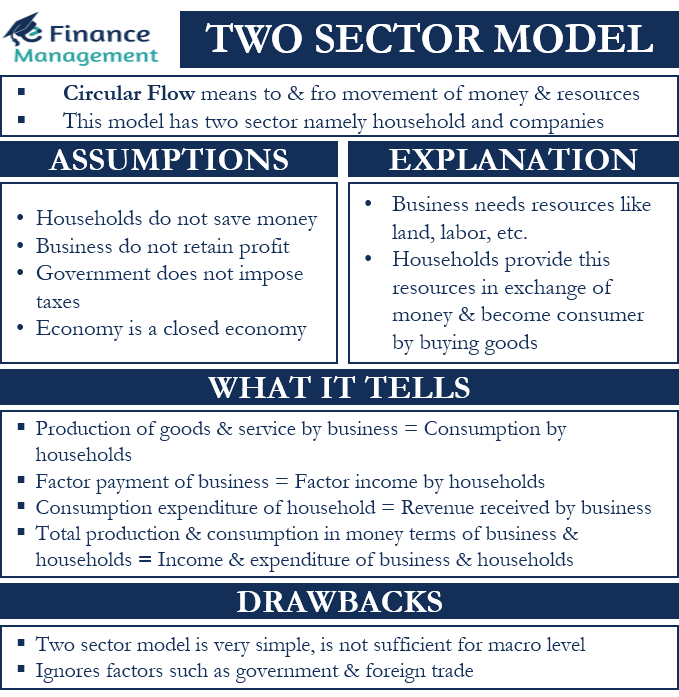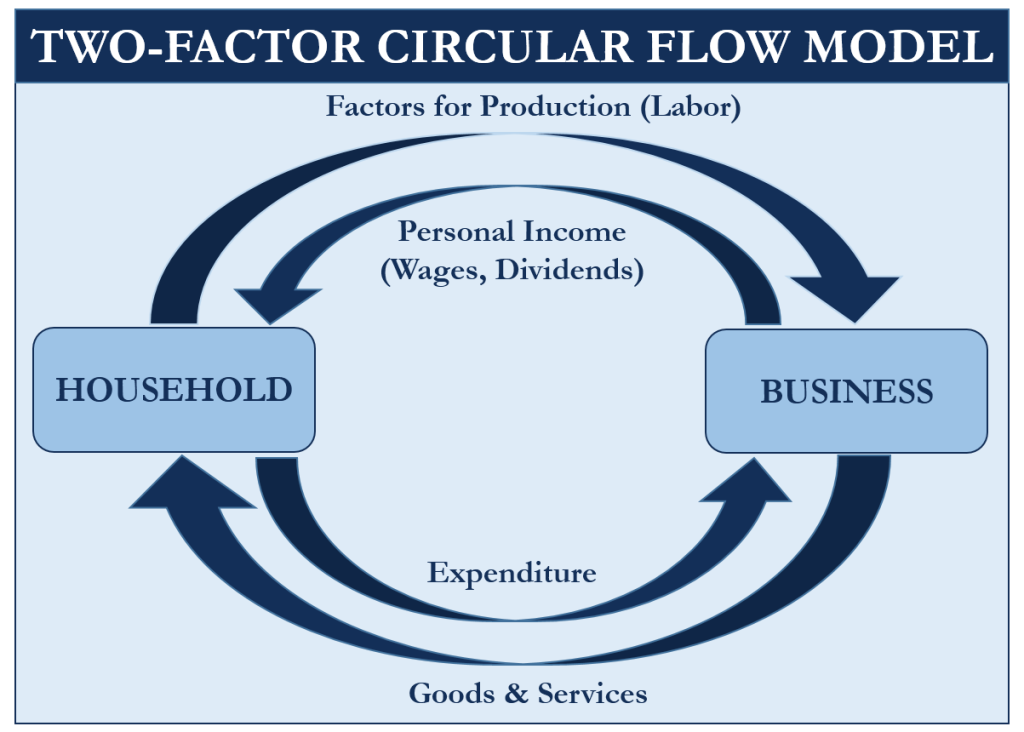What is Two Sector Economy?
In an economy, there is a flow of goods, services, and money among different sectors. By flow here, we mean the to-and-fro movement of money and economic resources among different sectors. We refer to such a phenomenon as the circular flow of income. Over the years, many economists have come up with their interpretation of the circular flow of income in a country’s economy. To explain this, they have developed a two-sector model, three-sector model, four-sector model, and five-sector model. These models are used to determine the national income.
When we say two or three or four or five sectors, the sector here means the number of sectors in an economy. The sector includes households, businesses, government, foreign trade, and the financial sector.
In this article, we will discuss about the two-sector model for income determination. In this model, there are just two sectors: households and businesses.
Assumptions of Two Sector Model
Following are the assumptions of a two-sector model:
- The total output of the economy is the sum of all the consumption and investments.
- Households do not save any money. In other words, they spend all the money they earn on buying goods and services i.e. consumption.
- Similarly, businesses do not retain any profits. This means they distribute all their revenue to households in the form of wages, rent, etc.
- The government does not interfere in the money flow. It means that government does not impose any taxes and regulations.
- The economy in which the two sectors operate is closed, meaning there is no foreign trade.
- The interest rate in the economy is fixed and stable.
- The labor rate also is fixed and stable.
- The consumption rate is also stable.
- The economy has not reached its full employment level.

Understanding Two Sector Model
The two-sector model is the most basic model explaining the circular flow of income. As said above, this model consists of just two sectors, and these are individuals or households and businesses. There remains no government intervention in terms of taxes and regulations. The investment is in auto mode.
Since there are just two sectors, this model assumes that households spend all their money on the goods and services offered by the businesses. Similarly, in the absence of any taxation, the businesses also distribute all their profits.
The following points will help in better understanding the two-sector model:
- Businesses need various resources to produce goods and services. These resources are land, labor, building, and more.
- Households make available these resources or factors of production to businesses. For example, households provide land and labor to businesses to carry out production. And in return, businesses pay money to households in the form of rent, wages, and more. In this way, the money flows from businesses to households.
- These households are also the customers of businesses. So, they use the money they get from businesses to buy goods and services. In this way, the money that household gets from businesses flows back to the businesses.
What does it tell?
This model concludes with the following facts:
- The total of goods and services that businesses produce equals the consumption of goods and services by the households.
- Factor payment by the businesses equals the factor income that households receive.
- Consumption expenditure of the households equals the revenue of the businesses.
- The total of production and consumption in money terms of businesses and households equal the income and spending of the businesses and households.
Diagram

In the diagram, the outer part shows the flow of resources, and the inner part reflects the money flow. The outer part (top) shows factor services flowing from households to businesses, and the bottom part shows the flow of goods and services from businesses to households.
The inner part (top) shows the flow of factor income (factor rent, wage, and more) flowing from businesses to households. And the bottom part shows the consumption expenditure flowing from households to businesses.
Drawbacks of Two Sector Model
- The two-sector model does not hold well in the real world as the economy consists of money movements from several sectors.
- Moreover, such a model is very simple and, thus, is not sufficient for macro-level understanding.
- This model ignores many important factors that are very relevant in the real world, such as the government, foreign trade, and more.
- Most of the assumptions (no savings, fixed rate of interest, fixed wages, etc.) are unrealistic.
The three or four-sector model considers these factors, and thus, they are better at explaining the circular flow of income. Therefore, this two-sector model is only of a theoretical value.
RELATED POSTS
- Three Sector Model: Meaning, Assumptions, and Diagram
- Circular-Flow Diagram Model
- Mixed Economy – Meaning, Characteristics, Advantages, and Disadvantages
- Socialist Economy – Meaning, Types, Advantages, and Limitations
- Centrally Planned Economy – Meaning, Features, Advantages, and Disadvantages
- Capitalist Economy – Meaning, Features, Pros, Cons, and Types

